S&P Global Offerings
Featured Topics
Featured Products
Events
S&P Global Offerings
Featured Topics
Featured Products
Events
S&P Global Offerings
Featured Topics
Featured Products
Events
S&P Global Offerings
Featured Topics
Featured Products
Events
Corporations
Financial Institutions
Banking & Capital Markets
Economy & Finance
Energy Transition & Sustainability
Technology & Innovation
Podcasts & Newsletters
Corporations
Financial Institutions
Banking & Capital Markets
Economy & Finance
Energy Transition & Sustainability
Technology & Innovation
Podcasts & Newsletters
ECONOMICS COMMENTARY — Jun 02, 2023
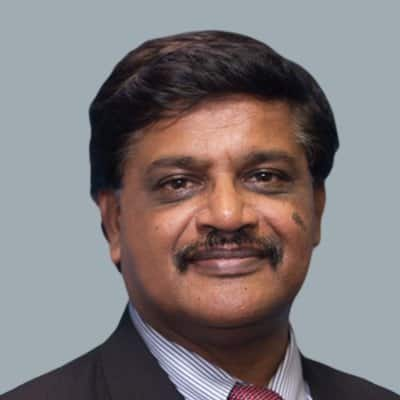
By Rajiv Biswas
Singapore's GDP growth slowed to a pace of 0.4% year-on-year (y/y) in the first quarter of 2023, after recording quarterly growth momentum of 2.1% y/y in the fourth quarter of 2022. The manufacturing sector remained weak, with manufacturing output contracting by 5.6% year-on-year in the first quarter of 2023, after declining by 2.6% y/y in the fourth quarter of 2022.
The near-term outlook is expected to remain constrained by weak demand in several important export markets for manufactures, notably the US and European Union (EU). However, the gradual recovery expected for mainland China's domestic demand during 2023 should help to mitigate the impact of weak US and EU orders. The service sector economy is expected to be more resilient, boosted by the continued recovery of international tourism travel in the APAC region.
Singapore's GDP growth rate in the first quarter of 2023 showed a marginal positive increase of 0.4% y/y in the first quarter of 2023, although contracting by 0.4% quarter-on-quarter (q/q). Economic growth momentum has slowed significantly due to the contraction in manufacturing output, which fell by 4.8% y/y and by 5.6% y/y in the first quarter of 2023.
The service sector also showed weak growth of 0.5% y/y and 2.0% y/y in the first quarter of 2023, contributing to the weak GDP outturn.
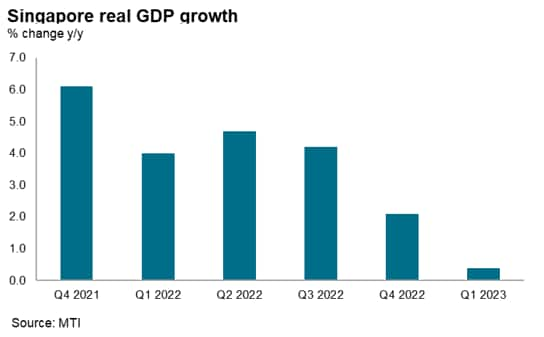
However, the gradual removal of many COVID-19 related restrictions since April 2022 supported buoyant growth in the accommodation segment, which grew by 21.9% y/y in the first quarter of 2023, helped by the rebound in international tourism visits. International visitor arrivals rose to 1.13 million in April 2023, a new post-pandemic record high, helped by strong tourism inflows from other APAC nations, notably Indonesia, Malaysia, India and Australia.
The headline seasonally adjusted S&P Global Singapore Purchasing Manager's Index (PMI) increased to 55.3 in April from 52.6 in March, to signal a back-to-back monthly improvement in the health of Singapore's private sector. Notably, the reading was the highest recorded since November 2022 and was consistent with a sharp rate of growth. A key driver of the improved headline reading was an accelerated rise in total new business placed with Singaporean private sector firms. The rate of new order growth was the best seen for five months, and frequently linked to firmer market conditions and improved client spending.
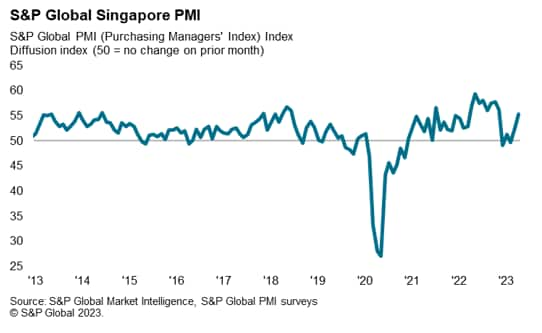
Latest statistics from Singapore's Economic Development Board showed that manufacturing output continued to weaken in April 2023, declining by 6.9% y/y and by 1.9% month-on-month (m/m). This sharp downturn reflected contraction in output of electronics, chemicals and biomedical manufacturing. Electronics output fell by 8.7% y/y while biomedical manufacturing fell by 11.1% y/y, the latter mainly reflecting a 14% y/y decline in pharmaceuticals output. Chemicals output contracted by 6.2% y/y, due to a combination of weak demand and plant maintenance shutdowns.
However transport engineering showed strong growth of 14.5% y/y, helped by a 24.2% y/y rise in output of the marine and offshore engineering sector, while aerospace engineering was up 16.1%.
Reflecting the weakness of manufacturing sector new orders since mid-2022, Singapore's non-oil domestic exports (NODX) fell by 9.8% y/y in April, following a 8.3% y/y contraction in March, according to latest data released by Enterprise Singapore.
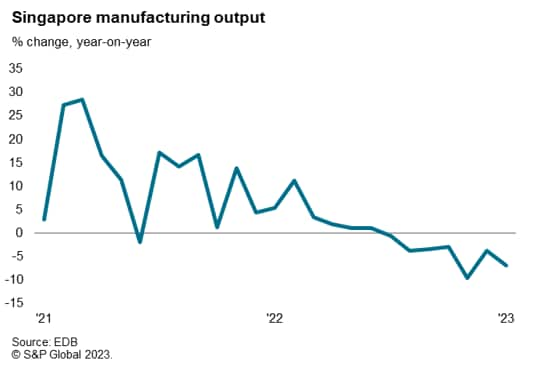
According to the February S&P Global Singapore PMI survey, prices data continued to show rapid increases in overall operating expenses faced by Singaporean private sector firms in April, although pricing pressures have moderated in the past twelve months. Underlying data indicated that purchasing costs rose at a sharper pace than staffing costs. Higher purchasing costs were often blamed on exchange rate movements and higher prices for shipping and raw materials. As part of efforts to protect operating margins, firms hiked their average selling prices again and at the quickest rate since January.
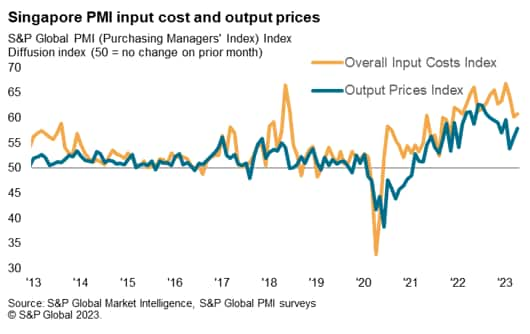
Singapore's CPI inflation rate was at 5.7% % y/y in April from 6.6% y/y in January. The Monetary Authority of Singapore (MAS) Core Inflation measure remained at 5.0% y/y in April, the same pace as in March.
The MAS and Ministry of Trade and Industry (MTI) estimate that for calendar 2023, taking into account the 1% increase in GST that took effect on 1st January 2023, headline and core CPI inflation are projected to average 5.5%-6.5% and 3.5%-4.5% respectively.
The electronics manufacturing industry is a key segment of Singapore's manufacturing sector, accounting for 40% of the total weight of manufacturing output, dominated by semiconductors-related production. S&P Global survey data since mid-2022 indicates that the global electronics manufacturing industry is continuing to face headwinds from the weak pace of global economic growth.
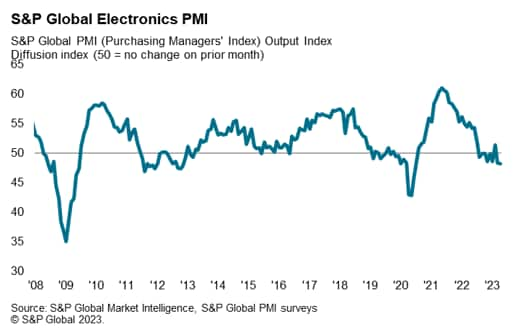
At 48.2 in April, the headline seasonally adjusted S&P Global Electronics PMI fell slightly from 48.4 in March to signal a sustained deterioration in operating conditions across the global electronics manufacturing sector at the start of the second quarter of 2023.
Weakening global economic growth momentum has impacted on consumer demand for electronics, with soft demand in mainland China also contributing to the downturn in new orders.
Singapore's non-oil domestic exports of electronics fell by 23.3% y/y in April, with exports of integrated circuits down by 21.1% y/y while exports of PCs fell by 50.3% y/y, according to exports data for April released by Enterprise Singapore.
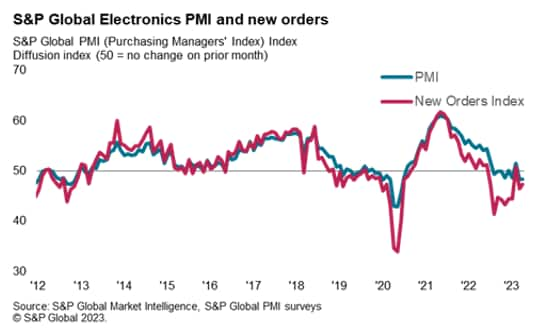
Exports of electronics products to mainland China remained very weak, declining by 23% y/y. Electronics exports to Taiwan were also weak, falling by 27.0% y/y. However electronics exports to the US showed only a marginal decline of 1.7% y/y, while exports to the EU fell by 7% y/y.
After a second year of rapid economic recovery from the pandemic in 2022, economic growth momentum has moderated significantly in early 2023. GDP growth is forecast to slow to 1.8% in 2023, after growing at 3.6% in 2022 and 8.9% y/y in 2021.
With continuing headwinds to global growth momentum in 2023 due to very weak growth in the US and EU, the outlook for Singapore's manufacturing sector remains challenging. However, there are early signs that domestic demand in mainland China is gradually improving, which should help to mitigate the impact of slowing export orders for Singapore's manufacturing sector in the US and EU during 2023. Stronger exports of services, notably due to rising international tourist arrivals, will also help to partially offset the impact of weaker growth in manufacturing exports.
The increase in Singapore's Goods and Services Tax by 1% from 7% to 8% implemented on 1st January 2023 will also act as a slight drag on economic growth in 2023, raising fiscal revenue by an estimated 0.7% of GDP per year. Singapore's Ministry of Trade and Industry has maintained its GDP growth forecast for 2023 in the range of 0.5% to 2.5%.
In 2023, taking into account the 1% increase in GST from 1st January 2023, headline and core CPI inflation are projected to average 5.5%-6.5% and 3.5%-4.5% respectively. MAS Core Inflation is projected by the MAS and MTI to remain elevated over the next few quarters, with risks still tilted to the upside, due to factors such as potential renewed shocks to world commodity prices and persistent global inflation pressures. Although prices of energy and food commodities have eased from their peaks, businesses will face higher utility prices and rising unit labour costs in the near-term. The MAS and MTI expect that MAS Core Inflation will moderate in the second half of 2023, as tightness in the domestic labour market eases and global inflation pressures moderate.
The medium-term outlook for Singapore's manufacturing sector is supported by a number of positive factors.
Prospects for Singapore's electronics industry remains favourable. The outlook for electronics demand is underpinned by major technological developments, including 5G rollout over the next five years, which will drive demand for 5G mobile phones. Demand for industrial electronics is also expected to grow rapidly over the medium term, helped by Industry 4.0, as industrial automation and the Internet of Things boosts rapidly growth in demand for industrial electronics. Singapore also remains an attractive hub for supply chain diversification for some high value-added segments of the electronics industry, as electronics manufacturers continue to diversify their supply chains for production of critical electronics products, notably semiconductors. Reflecting these trends, in 2022, Singapore attracted significant new foreign direct investment inflows into electronics manufacturing.
In the biomedical manufacturing sector, a number of new manufacturing facilities are being built by pharmaceuticals multinationals. This includes a new vaccine manufacturing facility being built by Sanofi Pasteur and a new mRNA vaccine manufacturing plant being built by BioNTech.
The aerospace engineering sector is currently experiencing rapid growth as the reopening of international borders in APAC is boosting commercial air travel across the region. Singapore's role as a leading international aviation hub is likely to continue to strengthen over the medium-term, helped by strong growth in APAC air travel and its role as a key Maintenance, Repair and Overhaul (MRO) hub in APAC.
In the service sector, Singapore is expected to continue to be a leading global international financial centre for investment banking, wealth management and asset management. Singapore will also continue to be a key APAC hub for shipping, aviation and logistics, as well as an important APAC hub for regional headquartering.
However, an important long-term challenge for the Singapore economy will be from ageing demographics. In Budget 2023, the Finance Minister stated that a key issue for the Singapore economy over the medium to long term will be from demographic ageing, with Singapore having one of the world's fasted ageing populations. The proportion of Singapore's population that is currently aged over 65 years is one-sixth of the population, but this will rise to an estimated one-quarter by 2030. This will result in rising healthcare and social welfare costs and could gradually reduce Singapore's long-term potential GDP growth rate. The role of fiscal policy in addressing demographic ageing will continue to be a key focus for government policy over coming years as the economic impact of demographic ageing intensifies.
Rajiv Biswas, Asia Pacific Chief Economist, S&P Global Market Intelligence
Rajiv.biswas@spglobal.com
© 2023, S&P Global Inc. All rights reserved. Reproduction in whole or in part without permission is prohibited.
Purchasing Managers' Index™ (PMI®) data are compiled by S&P Global for more than 40 economies worldwide. The monthly data are derived from surveys of senior executives at private sector companies, and are available only via subscription. The PMI dataset features a headline number, which indicates the overall health of an economy, and sub-indices, which provide insights into other key economic drivers such as GDP, inflation, exports, capacity utilization, employment and inventories. The PMI data are used by financial and corporate professionals to better understand where economies and markets are headed, and to uncover opportunities.
This article was published by S&P Global Market Intelligence and not by S&P Global Ratings, which is a separately managed division of S&P Global.
Location